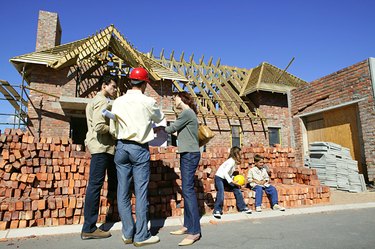
To insulate a wall assembly to R-23 is an easier task with new wall units. Existing walls present more of a challenge and will require a combination of approaches in order to get an R-23 insulation value. The United States Department of Energy recommends an R-value of R-11 to R-38 on the exterior wall assemblies of additions and new homes.
Considerations
Video of the Day
The size of the framing members, whether you have 2 x 4 or 2 x 6 walls, will determine the number of inches of insulation you can inside the wall cavity. A 2 x 4 cavity is 3 ½ inches deep. In contrast, a 2 x 6 cavity has 5 ½ inches of depth. You can put 3 ½ inches of insulation in a 2 x 4 wall and 5 ½ inches of insulation in a 2 x 6 wall.
Video of the Day
There are a wide variety of insulation materials that are used to insulated wall assemblies. Fiberglass batt, cellulose and wool are the most common type of products used in the interior wall cavities. The R-value of the products vary. The R-value measures the capacity of the insulation to prevent heat loss. R-value is usually displayed as the R-value per inch of material.
The fiberglass batt insulation fits in between the studs before the drywall or plaster is applied. Fiberglas batt insulation has an R-value of 3.1 to 3.5 per inch. Cellulose or wool must be blown into the existing walls. Cellulose has an R-value of 3.2 to 3.8 per inch and wool has an R-value of 3.0 to 3.3 per inch. Spray foam insulation can also be used to insulate walls. Rigid foam board can be used on the exterior. Both products have R-values of 3.6 to 7.0 per inch.
Installation Tips
Before you install the insulation, inspect the walls for evidence of moisture or air infiltration. Closed-foam insulation products can provide both high insulating and serve as a water barrier and air barrier. Fiberglass batt, cellulose and wool insulation will not prevent water or air penetration. Water will weigh the insulation down, leaving gaps and unprotected areas.
Any breaches in the thermal envelope, such as cracks, gaps or holes, should be repaired. One of the best methods for making the necessary repairs is spray foam in a can.
If your walls are made out of 2 x 4's, you can install R-13 or R-15 batt insulation. Spray foam will yield an R-7 per inch. There are some slow-expanding foam insulation products for existing walls, but the product can be applied easier in new wall systems.Nevertheless, if you were to get an R-7 per inch of spray foam insulation, you could get an R-23 in a 2 x 4 wall, which has a 3 ½ inch cavity. In wall systems comprised of 2 x 6 framing, install can take R-19 or R-21 batt insulation. To get an R-23 wall assembly you need to use a combination of batt or cellulose insulation for existing and rigid foam board on the exterior.
In new homes or remodeling projects which calls for new walls, builders and homeowners are using a combination of materials consisting of an initial layer of closed-cell spray foam and un-faced fiberglass batt insulation. The foam also functions as a water and air barrier. In addition, it has an insulating value of 7.0 per inch. The fiberglass batt insulation can be installed on top of the foam after it has cured.